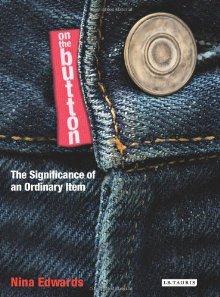One often finds Jane Austen popping up in the oddest places; and this one that I stumbled upon the other day points out a scene in Emma that one can so easily pass by without much notice [Austen being such an expert at this – and the reason for repeated readings!] – this time in a book on of all things, “Buttons”!
Nina Edwards new book, On the Button: The Significance of an Ordinary Item (London: Tauris, 2012), has this little gem in the introduction:
In Jane Austen’s Emma, when Emma contrives to find out if Mr. Knightley is considering Jane Austen romantically, buttons both betray his real affections to the reader and come to his aid by concealing his distress from Emma herself: (xix-xx, I have added a bit to the quoted text]
“I know how highly you think of Jane Fairfax,” said Emma. Little Henry was in her thoughts, and a mixture of alarm and delicacy made her irresolute what else to say.
“Yes,” he replied, “any body may know how highly I think of her.”
“And yet,” said Emma, beginning hastily and with an arch look, but soon stopping — it was better, however, to know the worst at once — she hurried on — “And yet, perhaps, you may hardly be aware yourself how highly it is. The extent of your admiration may take you by surprize some day or other.”
Mr. Knightley was hard at work upon the lower buttons of his thick leather gaiters, and either the exertion of getting them together, or some other cause, brought the colour into his face, as he answered,
“Oh! are you there? But you are miserably behindhand. Mr. Cole gave me a hint of it six weeks ago.”
He stopped. Emma felt her foot pressed by Mrs. Weston, and did not herself know what to think. In a moment he went on —
“That will never be, however, I can assure you. Miss Fairfax, I dare say, would not have me if I were to ask her; and I am very sure I shall never ask her.”
Emma returned her friend’s pressure with interest; and was pleased enough to exclaim,
“You are not vain, Mr. Knightley. I will say that for you.”
He seemed hardly to hear her; he was thoughtful, and in a manner which shewed him not pleased, soon afterwards said,
“So you have been settling that I should marry Jane Fairfax.”
(Emma, Vol. II, Ch. XV)
Here the gaiters seen to represent his morally dependable (but compared with the dashing Henry Crawford*) unexciting character; the buttons provide a refuge, the simple task of buttoning masking his emotion.
******************
what Mr. Knightley was so busily buttoning
image: Gaiters, 1805-10, British, the MetMuseum.org
(*I think she must mean Frank Churchill here, as Mansfield Park is nowhere in sight…!)
Isn’t this a wonderful passage? – one forgets how clearly Austen has strewn clues throughout the book as to Knightley’s true affections. Significant indeed! And it harks back to the scene with Emma contriving to repair her broken boot-lace to aid Mr. Elton and Harriet in their “courtship.”
Any thoughts?
The book, by the way, for anyone who has an interest in fashion and its cultural history, and especially the all-important button, looks quite wonderful:
What do you use every day that is small and large, worthless and beyond price? It’s easily found in the gutter, yet you may never be able to replace it. You are always losing it, but it faithfully protects you; sexy and uptight, it is knitted in to your affections or it may give you nightmares. It has led to conflict, fostered and repressed political and religious change, and epitomizes the great aesthetic movements. It’s Eurocentric, and is found all over the world.
On the Button is an inventive and unusual exploration of the cultural history of the button, illustrated with a multiplicity of buttons in black and white and color. It tells tales of a huge variety of the button’s forms and functions, its sometimes uncompromising glamour, its stronghold in fashion and literature, its place in the visual arts, its association with crime and death, and its tender call to nostalgia and the sentimental. There have been works addressed to the button collector and general cultural histories, but On the Buttonlinks the two, revealing why we are so attracted to buttons, and how they punch way above their weight.You can view it here: http://books.google.com/books/ibtauris?id=Rb46WTFfQAAC&dq=jane+austen&source=gbs_navlinks_s



